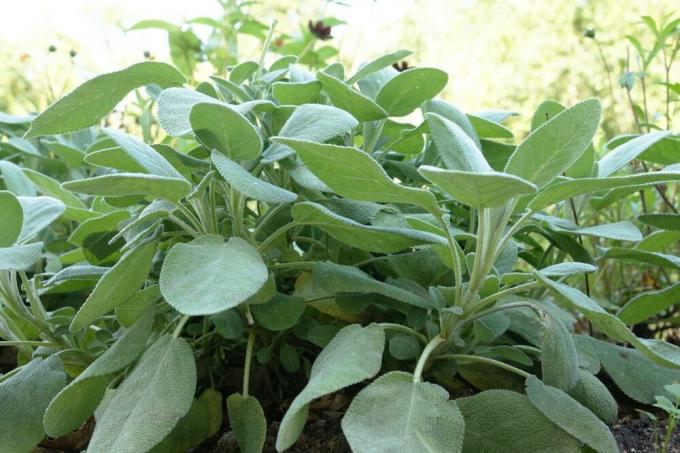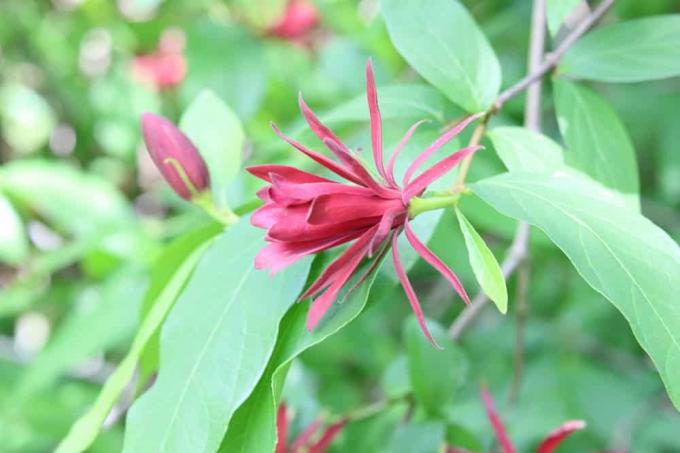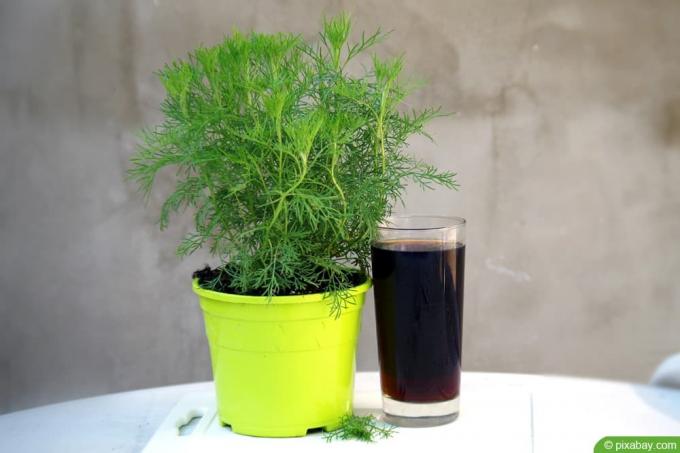

Table of contents
- preserve sage
- Harvest fresh sage
- Thoroughly clean the sage
- Preserve sage in air
- Eliminate the moisture in the oven
- Quick drying in the microwave
- Preserve sage in the dehydrator
- Store dried sage properly
- Important instructions
A lot of good things for us humans lie dormant in the silver-green leaves of sage. The intense aroma gives our dishes a touch of spice. Its essential oils are extremely healing: sage tea soothes a sore throat in a gentle, natural way. Unfortunately, it can only be harvested fresh in the garden in summer. But thanks to careful drying, sage is available to us all year round.
preserve sage
Sage does well in our home gardens. Over the years, it can develop into a handsome shrub that sprout plenty of green leaves in summer. Freshly harvested and then immediately processed sage tastes best and contains a lot of essential oils. But after flowering, the amount of essential oils decreases and the harvest is over at the latest with the first frosts. So that the sage does not disappear from our menu for months, a dry supply for the winter can be easily created from the abundance of leaves. Its soothing effect as a tea is in demand when the throat hurts and calls for relief. The sage can be frozen to preserve it, but drying is more advantageous. The sage retains its flavor longer than when frozen. There are several options for drying:
- in the air
- in the oven
- in the microwave
- in the dehydrator
Harvest fresh sage
The essential oils are what makes sage so special. They provide the desired aroma in food and have a healing effect in natural medicine. It is therefore important to get as much of it as possible in the dried leaves. In order for this to succeed, the freshly picked leaves should contain as many essential oils as possible. Above all, the right harvest time is of crucial importance here, because their concentration is not consistently high.
- Use leaves with lots of essential oils
- Aroma content in the leaves varies
- it is highest a few days before flowering
- therefore, the ideal harvest time is early summer to mid-summer
- Picking leaves before the midday sun
- Use sharp secateurs or a clean knife
- Cut off the tips of the shoots or entire branches straight off
- Flowers are not suitable for use
Tip:
Rinse the shrub gently with water the evening before harvest. The leaves become so clean and also have time to get rid of the wetness before harvest.
Thoroughly clean the sage

If the sage is cleaned with water immediately before further processing, it has a harder time drying. However, sometimes there is no way around it. Especially when it is growing outdoors, when wild sage is picked or when animals may have come into contact with it, it needs to be washed.
- shower whenever possible the evening before harvest
- otherwise wash before drying
- Rinse the leaves briefly
- use cold to lukewarm water
- Gently pat the leaves dry with paper towels
- Discard leaves with spots and withered parts
A notice:
Freshly harvested and cleaned sage should be processed or dried as soon as possible. Long storage has a negative effect on the subsequent taste.
Preserve sage in air
Sage sprigs hanging in the air gradually lose their moisture until they are completely dry. This is a simple method of preserving sage that requires nothing more than sage and a little patience. However, since this type of drying takes some time, the sage loses some of its essential oils.
- Tie shoots together with thread
- in bouquets with 6 to 10 branches each
- hang upside down
- dark and dry room is ideal
- alternatively: place individual sheets on newspaper
- Drying takes about 1 to 2 weeks
- Drying time depends on the weather
- after that store sage in a container
Tip:
The room in which the sage was hung to dry should be ventilated regularly. This allows the moisture to escape and the sage to dry safely without becoming moldy.
Eliminate the moisture in the oven
Sage can be turned into a storable herb in an oven faster than in air. The whole process is completed within a day and the sage is completely dried. In this way, more flavorings are retained than when air-dried.
- Harvest the sage fresh. The fresher the leaves are, the more essential oils they contain.
- If necessary, clean the sage with lukewarm water.
- Then gently pat the leaves dry with kitchen paper.
- Preheat the oven to 40 to 50 degrees circulating air.
- Line a baking sheet with parchment paper.
- Distribute the sage leaves on the baking paper without touching the individual leaves.
- The baking sheet can now be placed in the oven.
- Leave the oven door ajar to allow moisture to escape.
- The leaves should be turned by hand about every 30 minutes.
- After about 6 to 8 hours the leaves are completely dry.
- Rub a few leaves between your fingers. If they rustle and crumble, the sage is really dry.
- Let the sage cool completely.
- 1Pour the cooled sage into a suitable screw-top jar.
Tip:
Wait until the optimal harvest time, just before flowering, when the essential oil content is at its highest. You will be rewarded with a more intense aroma and higher healing power.
Quick drying in the microwave

If you are in a hurry and have a microwave, you can also preserve the sage this way. It is one of the few types of herbs that can be dried in the microwave. The process is similar to that in the oven, except here everything happens at a rapid pace typical of microwave ovens. However, the speed also has a disadvantage: the intensive treatment leads to a loss of flavorings. Sage dried in the microwave is therefore particularly suitable for drying arrangements or as incense material.
- Prepare the freshly harvested sage for drying by rinsing it off with lukewarm water and then patting it dry with kitchen paper.
- Cut a piece of parchment paper suitable for the microwave and line it with it.
- Arrange the sage leaves on top without touching the individual leaves. Alternatively, you can place the leaves in a microwave-safe dish.
- Set your microwave to 150-200 watts and run it for about 10-20 seconds.
- Then open the microwave door to allow the moisture to escape.
- Check how far the sage has dried.
- If the sage is still wet, turn the leaves over and start another 10 second pass.
- Repeat the drying process until the sage is completely dry.
Tip:
Wait for the sage to cool before placing it in a dark jar. If the sage is still warm, condensation can form and affect the shelf life.
Preserve sage in the dehydrator
Anyone who owns a dehydrator can use it to preserve sage particularly easily and conveniently. Purchasing a new dehydrator can also be worthwhile, especially if there is a large harvest of vegetables, fruit and herbs in the garden. Because a dehydrator is suitable for preserving many garden products. This method works like an oven in that warm air flows around several sieve trays. However, a dehydrator is particularly energy-efficient compared to the oven. Also, the oven is not blocked for many hours.
- Pick the sage fresh and before the midday sun has a chance to shine on the bush.
- Rinse the leaves under running water to wash away any dirt.
- Wet sage will take longer to dry, so gently pat dry before placing in the dehydrator.
- Distribute the sage leaves on the sieve bottom, leaving about 20% of the area free.
- Remove unnecessary screens. No other parts of the plant may be in the dehydrator during the drying process.
- Turn on the dehydrator to the number of degrees recommended in the instructions for use.
- The drying process should be complete after about 6 to 7 hours. The leaves should still be slightly green and pliable.
Store dried sage properly

So that the sage retains its aroma for a long time and is therefore useful to you, it should be stored properly after drying. Optimally stored sage retains its essential oils and thus its taste and healing properties for a long time.
- Sage must be completely dried
- Store correctly immediately after drying is complete
- use a suitable storage container
- Airtight jar is best
- store cool and dry
- Container is labeled and dated
- Shelf life depends on storage conditions
- with suitable storage it is about 2 years
A notice:
Storing sage that is not completely dry can lead to mold growth. A dryness test should therefore be carried out before storage. If the leaves rustle and crumble when touched, the sage is dry.
Important instructions
In addition to many welcome substances, sage also contains toxic thujone. Medicines based on sage are therefore not suitable for long-term use. This also applies to the sage tea. In the kitchen, on the other hand, sage can be used without hesitation to season dishes, since the dose used is small.
 garden editorial
garden editorial I write about everything that interests me in my garden.
Learn more about herbal recipes

Make herbal lemonade yourself | 12 delicious recipes
Herbal lemonades are delicious, thirst-quenching and healthy and easy to make yourself with the right recipe. A long-lasting supply can be built up with homemade syrup made from herbs. At Hausgarten.net you will find the best recipes to make yourself.

Real spice bush, Calycanthus floridus: care from A to Z
The spice bush brings a spicy scent to the garden. It is reminiscent of cinnamon, camphor and other spices. In the flowering period, it looks very attractive with its rust-red flowers. Caring for the garden is not very demanding. There are tips on how to do this in the guide.

Make herbal salt yourself | 7 recipes for fresh & dried herbs
Making herbal salt yourself is easy and practical. Because fresh herbs can easily be preserved with it and an individual spice mixture can be prepared. Suitable recipes for fresh and dried herbs can be found here.

Colakraut Syrup - How to make cola without caffeine & 4 delicious recipes
Colakraut is also known under the name southernwood and has - as the name already suggests - an intense cola aroma. With the right recipes, syrup, lemonade and liqueur can be made from it. Here we tell you how you can do it yourself.

15 tips for cutting, propagating, harvesting & drying olive herb
While thyme can be found in almost every herb bed, the olive herb is considered an exotic rarity with its comparable, spicy taste. The gardener gives a lot of thought to the preservation of the small peculiarities of his garden. "How should I prune the plant and when can I harvest the herb?" In this guide he will find 15 helpful tips for the right cut, propagation and subsequent use.

Make your own herbal liqueur 5 recipes for herbal schnapps
After a hearty meal or when you have a stomach ache, a herbal schnapps works wonders. Icons in the herbal liqueur heaven, such as Jägermeister and Ramazotti, demonstrate a variety of pleasure variations and strictly guard their legendary recipes. These 5 recipes for herbal schnapps reveal how you can easily make the beneficial spirit drink yourself.
